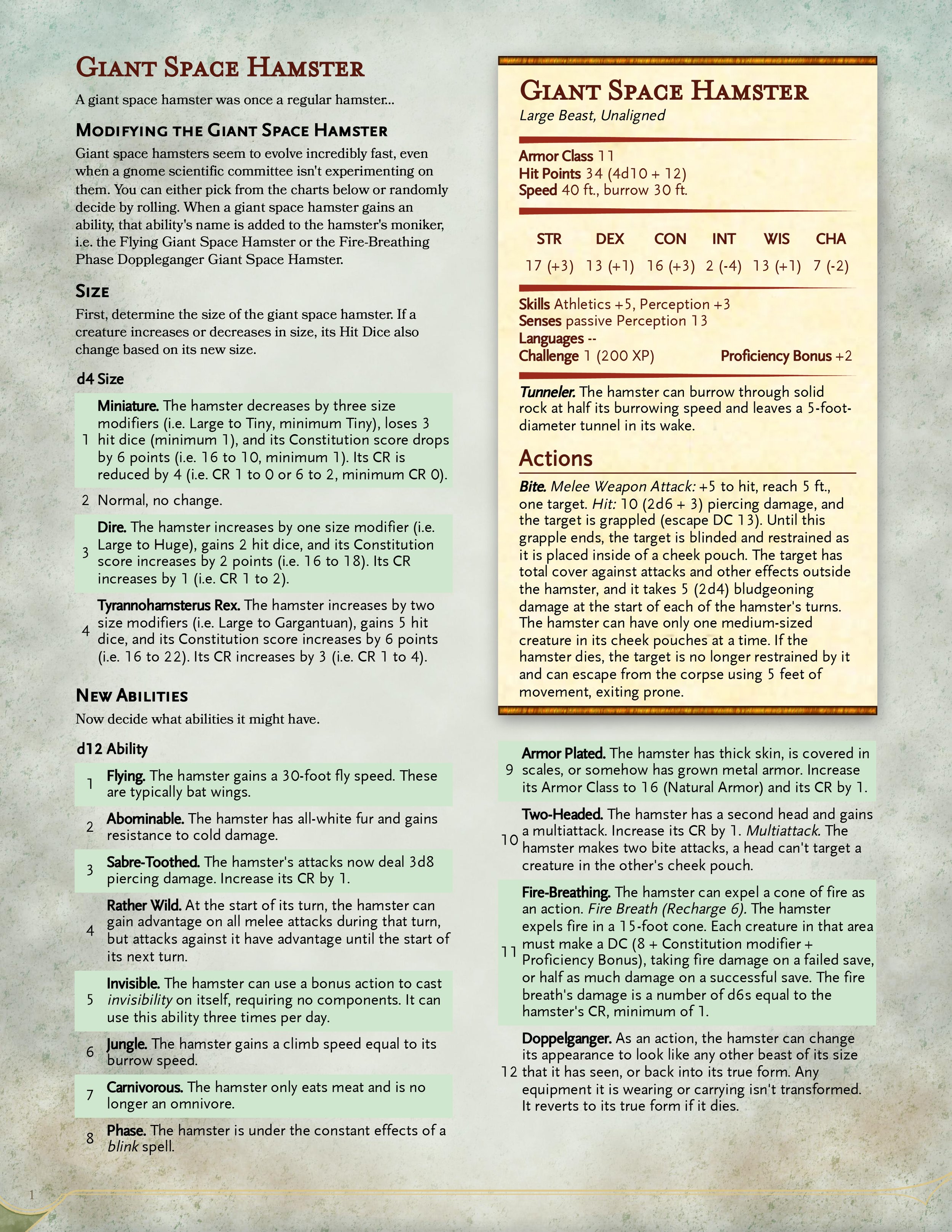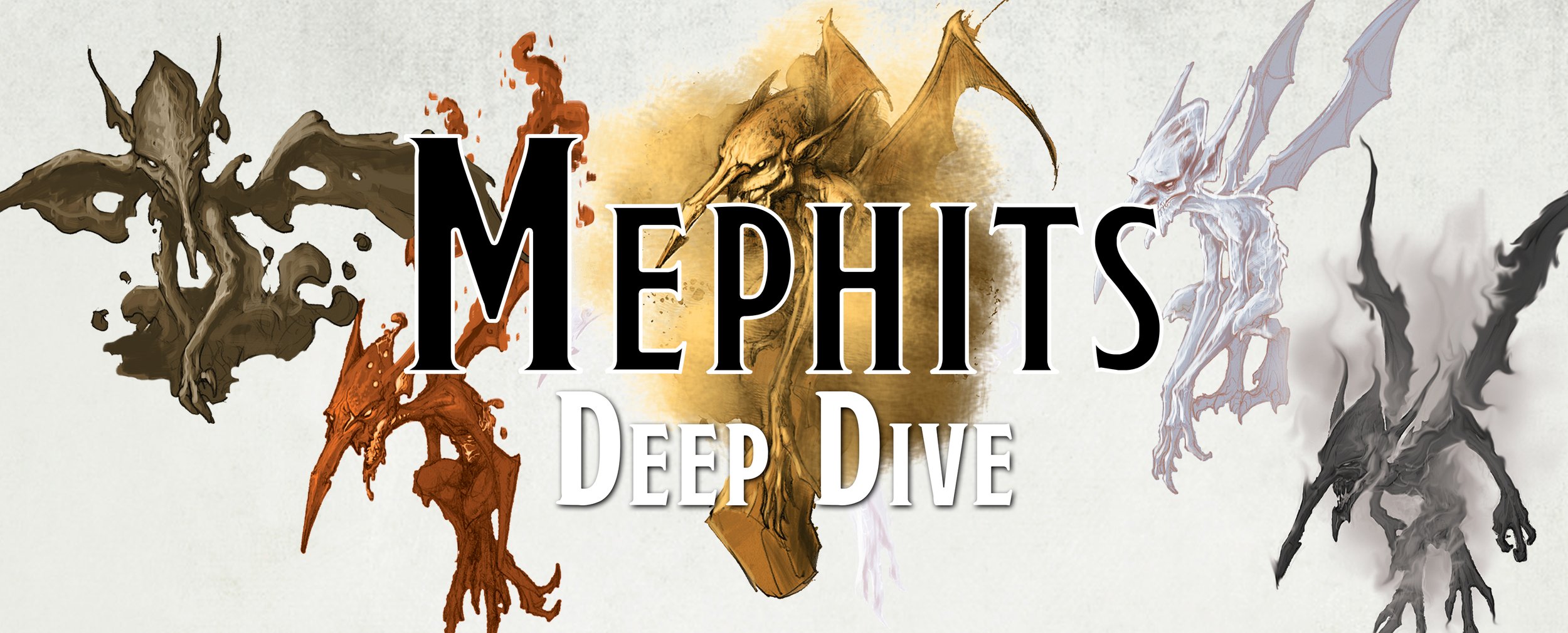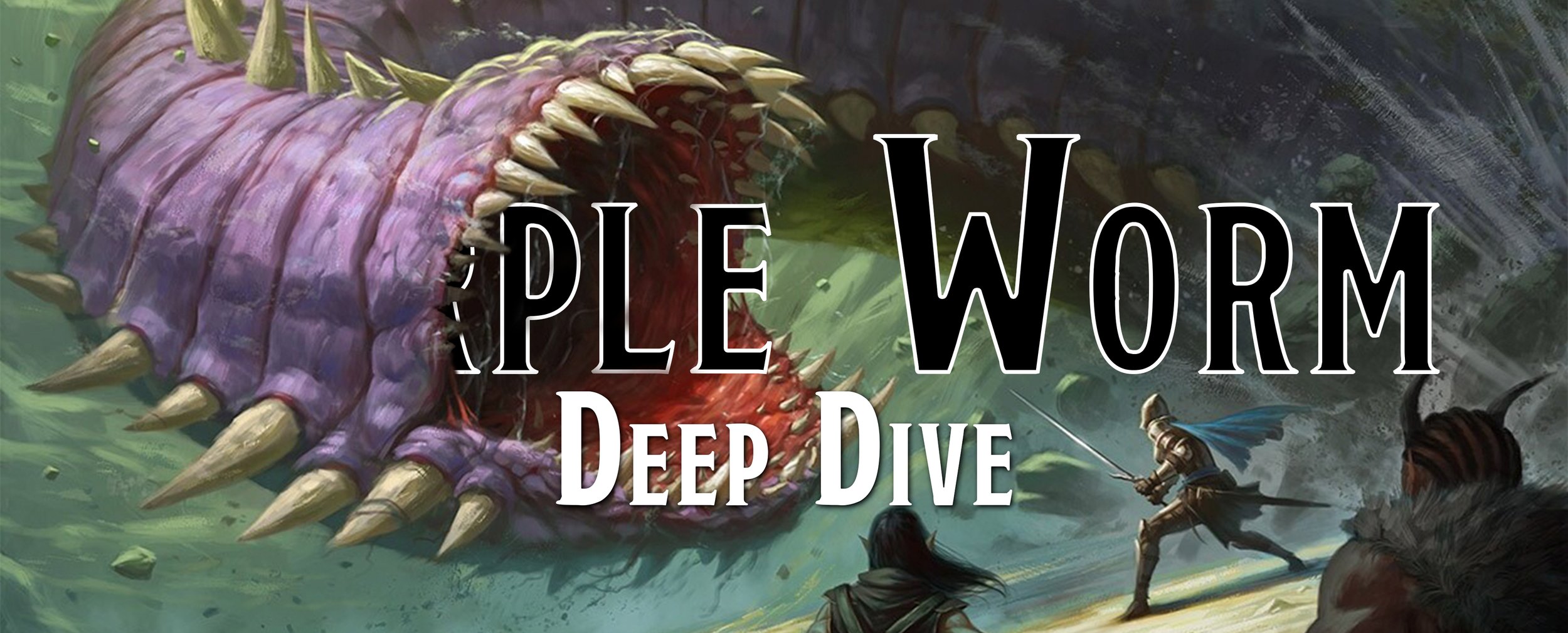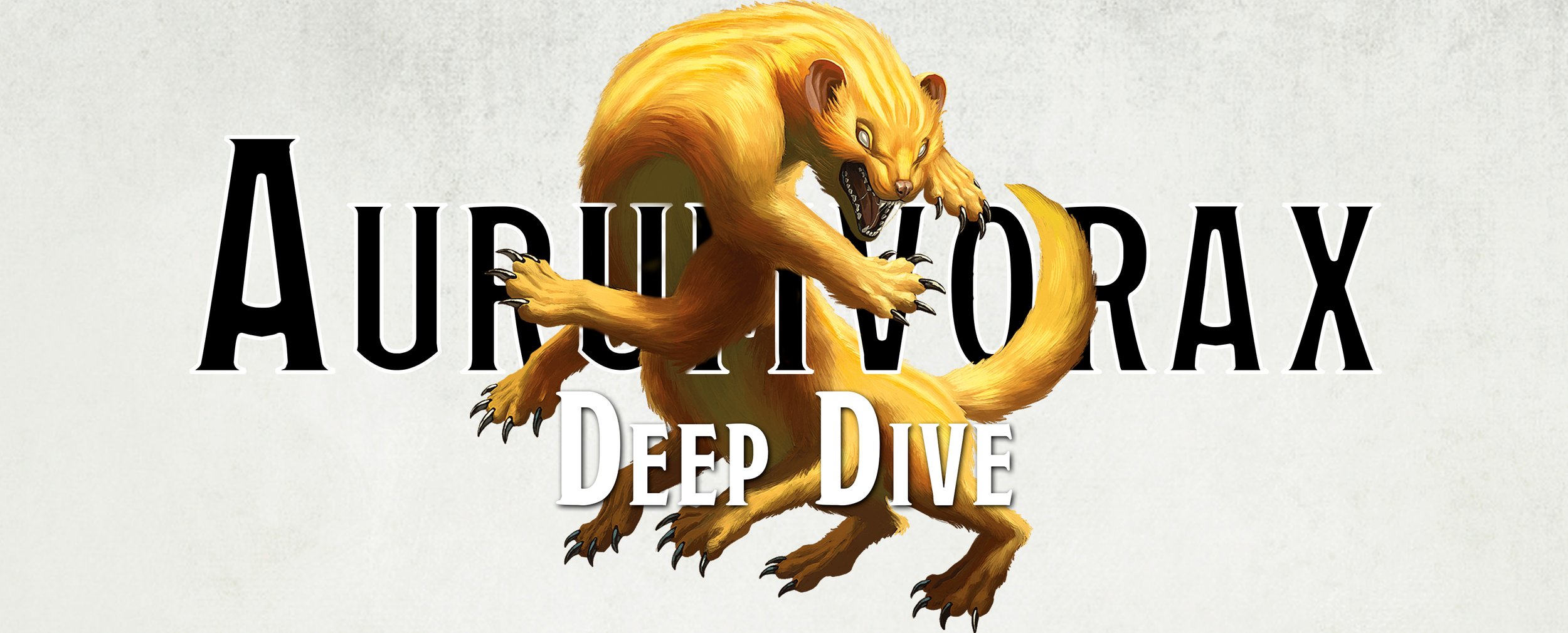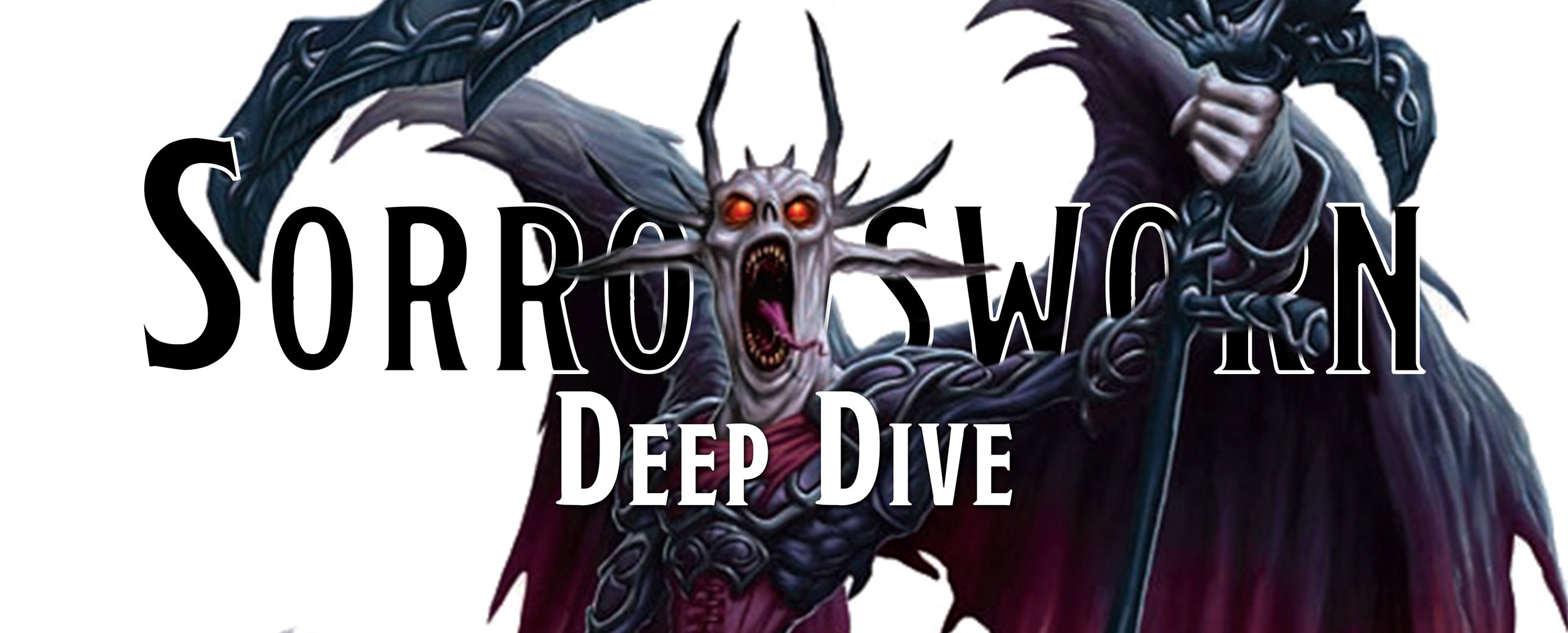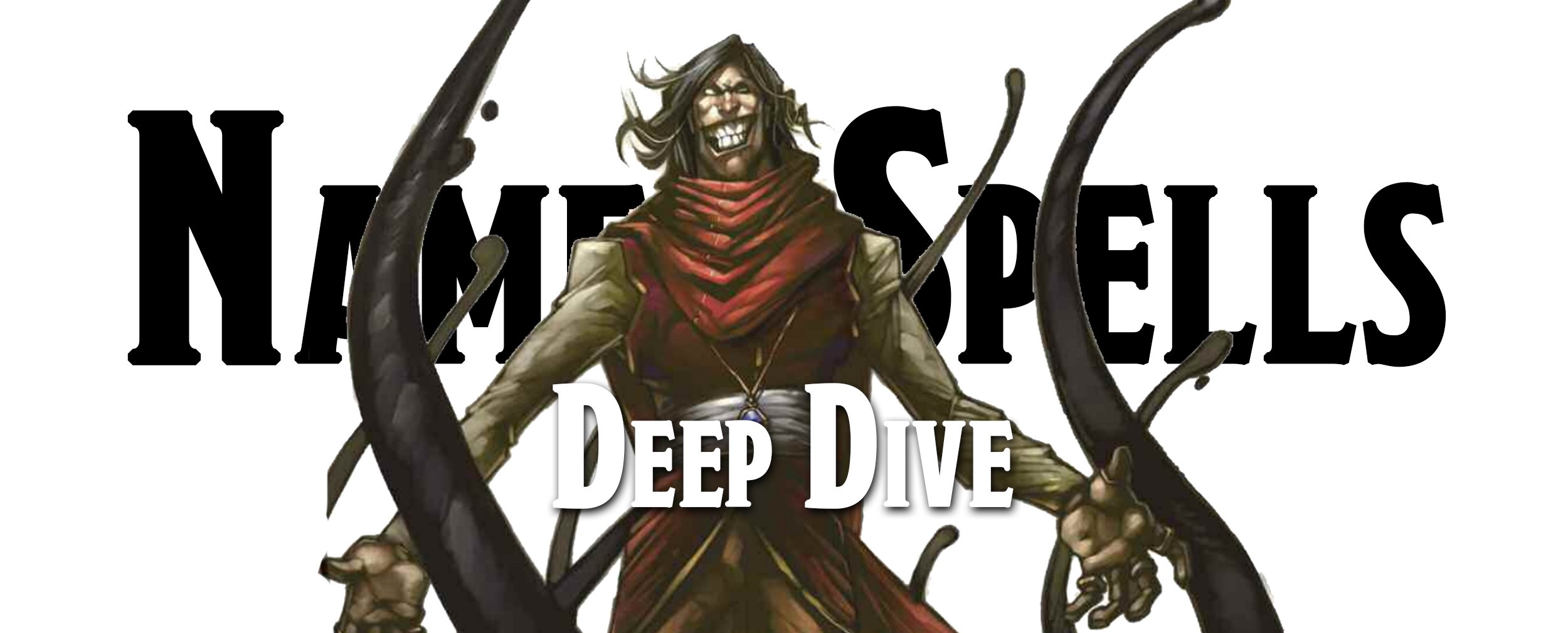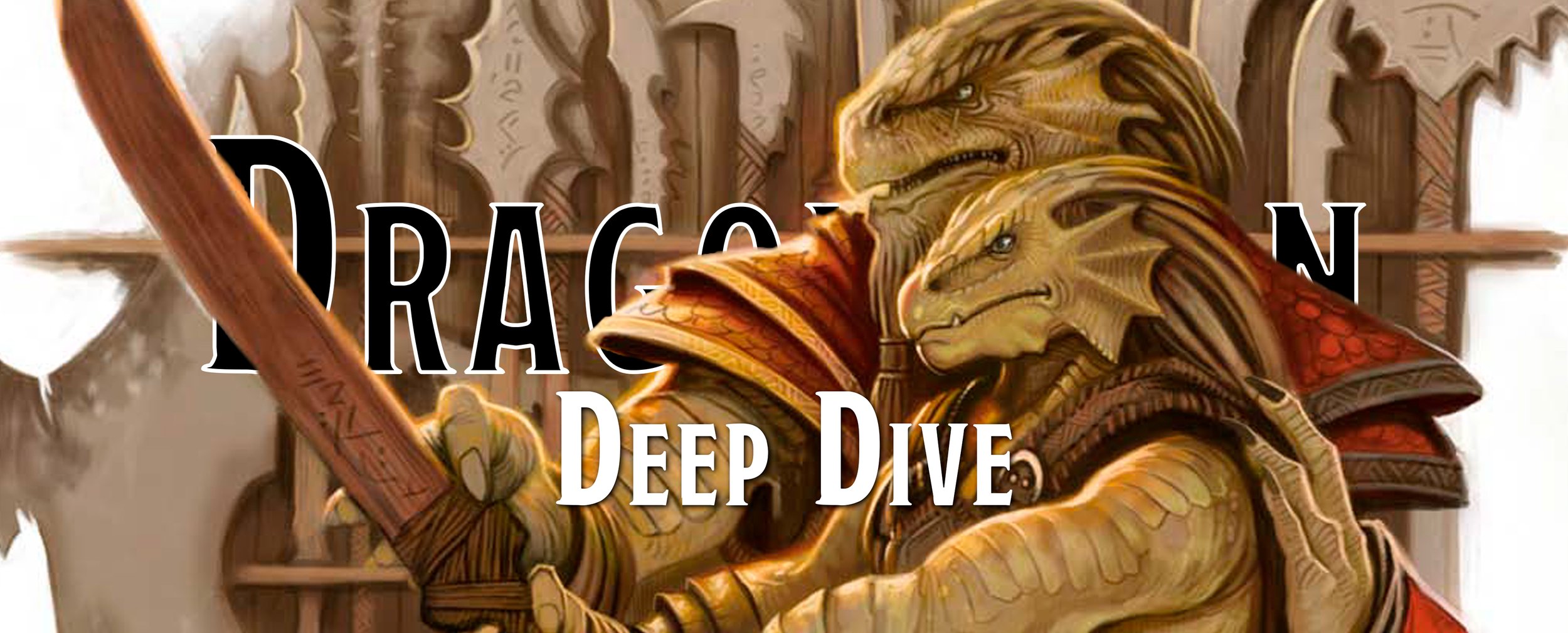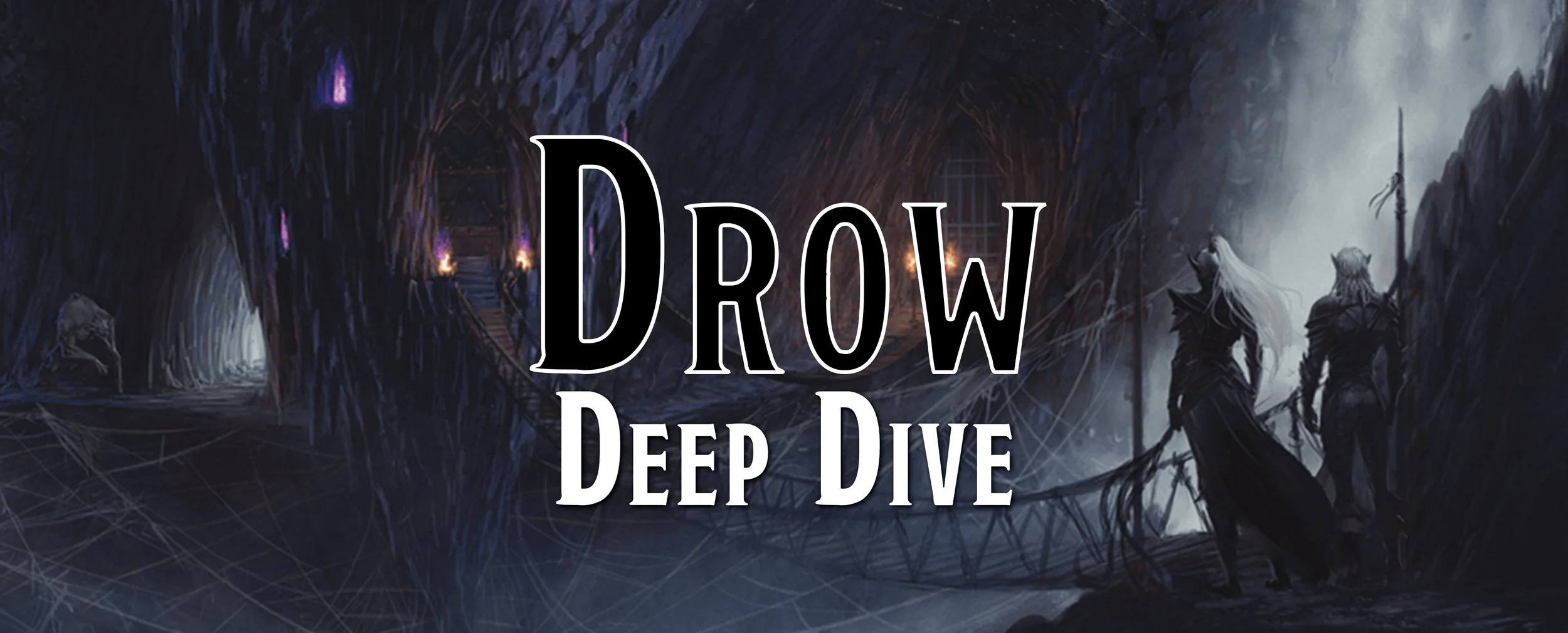Deep Dive - One-Shot Wonders
In honor of April Fool’s tomorrow, we have decided to look at some monsters you might have first thought were a giant April Fool’s joke. The criteria for these monsters is that they only show up in one or two editions, at most, so no flumphs will be found here. These monsters are weird, odd, and kind of confusing. We aren’t sure how they ever got approved, but we are very happy they did.
1e (AD&D) - Tirapheg
Frequency: Very Rare
No. Appearing: 1
Armor Class: 10
Move: 3”
Hit Dice: 2
% in Lair: 20%
Treasure Type: Nil
No. of Attacks: 3
Damage/Attack: 1-4/1-4/1-4
Special Attacks: Strangle
Special Defenses: Illusions
Magic Resistance: Standard
Intelligence: Average
Alignment: Neutral
Size: M (7’ tall)
Psionic Ability: Nil
Level/X.P. value: III/73+2 hit point
Fiend Folio, 1981 TSR Inc.
We begin in the Fiend Folio (1981) with one of the most bizarre and strangely terrifying creatures we have ever seen, the Tirapheg. It probably has something to do with its appearance, that of a three-legged, three-armed, three-eyed, and three-headed nightmare… yeah, it’s definitely its appearance that terrifies us.
We aren't sure where to start when describing the Tirapheg. It's 7 feet tall, pale white, naked, and is entirely void of any body hair. It is listed in the description as a hermaphrodite, but we don’t see any of its plumbing in the picture, unless that’s the third leg. We prefer just to assume they are referring to only internal male and female organs and leave it at that. In addition, we are told that the Tirapheg has a human-like shape, and if we stretch our imagination, we can see it if we close our eyes and attempt to forget its horrifying form. Unfortunately, its haunting image refuses to leave our accursed sight.
As mentioned before, the Tirapheg has three heads, but only the center head has facial features. The front of the central head has two big creepy eyes to go along with its oddly normal human nose. Lest we forget, the Tirapheg also has an eye set in the center of the back of its head. What is called ‘ear organs' sit where ears should be, but there is no mouth anywhere on its face. If you're wondering about the other two heads, you'll be happy to know they are effortless to describe. They have no features whatsoever. The heads sit on either side of the center head, blank as a chalkboard during summer break. Now that we think of it, you may not be happy about that.
Now we get really weird. The body of the Tirapheg has three arms. The first two sprout from its shoulders, almost like yours and ours do, like normally shaped creatures. The difference is these arms are way past double-jointed as the Tirapheg can use them to attack you from the front and back. There are no hands at the end of these arms either. They end in a 6-inch spike that deal 1d4 damage when the creature attempts to skewer you. The third arm springs forth from the center of the Tirapheg's chest. We're not sure if the three long fingers at the end of this arm qualify as a hand, and quite frankly, we don't want to know.
If those two spiked tipped arms both hit you in a round, you'll feel those three fingers on the center arm wrap around your throat and begin to strangle you. It's not the most enjoyable sensation, but you'll get a real nice closeup of its mouth. Directly under this center arm is where the Tirapheg's mouth is located. It seems fitting that the creature's mouth is located in its armpit, though on a proper human body you'd call that section the stomach. Right above the mouth is three long, writhing tentacles, whose purpose is unknown to this day. It won't try to nibble on you, but the Tirapheg's breath will indeed stink. The creature only eats rotting flesh, so you'll be long dead before it consumes the decomposing skin from your bones.
The bottom half of the Tirapheg isn't any prettier than the top. A Tirapheg has three legs. The outer two legs end in stumps, kind of like its outer arms. The middle leg, much like the middle arm, ends in three long and strong toes. Feels like a lost opportunity for some crazy kicks with the center leg while the two stump legs are planted for balance, but what do we know. The creature moves with the speed of a sloth, even with three legs, so you’ll at least get a few seconds to try and puzzle out this odd creature as it shambles towards you.
A Tirapheg will generally avoid you, but may attack you and your friends without warning if it's in a mood. When you gang up on the poor and misunderstood Tirapheg, it will want to retreat. Knowing it isn't the most fleet of foot monster in the world, the Tirapheg uses its one unique ability, creating two illusions of itself. Replicas are a more apt description since they will attack and damage just as the Tirapheg itself does, they just can’t take damage. When the Tirapheg creates these illusions, a flash of blinding light is produced, helping mask the real Tirapheg amongst the illusions. If you are within 30 feet of the Turapheg, you are stunned for the round, standing still with your mouth agape. The charade ends when you realize they are illusions, the Tirapheg is killed, or the creature manages to shamble off out of sight. So, it's a good idea to chase after the Tirapheg, while it slowly pogosticks away from the bloodshed.
2e - Giant Space Hamster
Climate/Terrain: Temperate/Grassy plains and hills
Frequency: Common to very rare
Organization: Small pack
Activity Cycle: Night
Diet: Omnivore
Intelligence: Animal (1)
Treasure: Nil
Alignment: Neutral
No. Appearing: See below
Armor Class: 8
Movement: 9, Br 3 (hard earth)
Hit Dice: 4
THAC0: 17
No. of Attacks: 1
Damage/Attack: 2-8
Special Attacks: Nil
Special Defenses: Immune to disease
Magic Resistance: Nil
Size: L (up to 9’ long)
Morale: Unsteady (6) (if wild: Average (9))
XP Value: 175
Monstrous Compendium Spelljammer Appendix, 1990 TSR Inc.
Released in the Monstrous Compendium Spelljammer Appendix (1990), the Giant Space Hamster is exactly what you might think. It is a giant hamster… in SPACE! Well, not technically in space, as they can’t survive the vacuum of space, but they can be found on gnome spelljammers on giant wheels that they run along, providing an immense amount of power to the ship. It’s about as ridiculous as you might expect from a creature genetically experimented on by a spacefaring gnome civilization who uses massive rubber bands to power their spelljamming vessels.
But, you don’t have to be on a gnome spelljammer to witness the majesty of these fearsome hamsters. They are found on various worlds on huge hamster ranches run by gnomes, who use them not just as beasts of spelljamming burden, but also as a delicacy. Giant Space Hamster, apparently, is the greatest food that all gnomes love, and they have affectionately named this type of meat as spaham - a portmanteau of, what we assume is, spam, space, ham, and hamster. Gnomish colonies, who run out of Giant Space Hamster meat, will send out expeditions of fearless Hamster Hunters, all seeking that delightful spaham to bring back to their homes and hold massive feasts.
If you find yourself interested in trying a bit of spaham, well the good news is you probably can’t miss a Giant Space Hamster if it happens to be anywhere near you. They are 9-feet long, they must eat over 30 pounds of food a day, and drink 10 gallons of water. They roam about in packs of up to four, not including their young, and have several litters every year. They aren’t especially dangerous creatures, as they only have a single bite attack, but if they do bite you, you may end up inside of their cheek pouches which can hold over 200 pounds of food. Wild Giant Space Hamsters burrow into hills, making huge tunnels that are six feet wide and up to 180 feet long. Unfortunately, they have many predators, since while they may fill the same ecological niche as say an elephant, they have little in the way of protection.
We mentioned before that they are the genetic experiments of gnomes, well, the gnome research committee that created them made a few additional variations as science, in their opinion, hadn’t yet gone far enough. Of course, we can’t blame gnomes for everything, even though we really would like to, as they also gain a few variations thanks to consuming enchanted substances from across the worlds they were seeded on.
Monstrous Compendium Spelljammer Appendix, 1990 TSR Inc.
These variations can be as minor as having a nasty overbite, like with the Sabre-toothed Giant Space Hamster, to being able to make yourself invisible at will like with the Invisible Giant Space Hamster. Even though gnomes aren’t the most creative with their names, it at least gives you a very clear idea of how a Carnivorous Flying Giant Space Hamster is going to use its bat wings to fly up to you and rip you apart with its fearsome claws or how the Miniature Giant Space Hamster is just the size of a regular hamster.
There are two hamsters that we think take the cake, the Fire-Breathing Phase Doppleganger Giant Space Hamster and the Tyrannohamsterus Rex. The Fire-Breathing Phase Doppleganger Giant Space Hamster, or FBPDGSH for short, can not only phase in and out of the material plane and into the ethereal plane, it also breathes fire, changes its shape at will (so long as it is roughly a bear-sized mammal), and reportedly, the gnomes who are responsible for it, were sent to jail for crimes against gnome society. The Tyrannohamsterus Rex, on the other hand, is immense at 25 feet tall and weighing over 75 tons. While it may be fearsome to behold, it is scared of everything and actually has no natural attacks it can make unless it happens to step on you by accident. It is frightened by all magic, sudden noises, fire, and more, causing it to panic and flee, trampling and destroying everything in its way. The gnomes responsible for this abomination claim they only made this species “because it was there”.
3e/3.5e - Grisgol
Large Construct
Hit Dice: 19d10+30 (134 hp)
Initiative: +0
Speed: 30 ft.
Armor Class: 28 (–1 size, +19 natural), touch 9, flatfooted 28
Base Attack/Grapple: +14/+22
Attack: Slam +17 melee (1d6+4 plus 1d8+5 negative energy plus paralysis)
Full Attack: 2 slams +17 melee (1d6+4 plus 1d8+5 negative energy plus paralysis)
Face/Reach: 10 ft./10 ft.
Special Attacks: Choking dust, damaging touch, paralyzing touch, spell-like abilities
Special Qualities: Construct traits, damage reduction 10/ piercing and magic, darkvision 60 ft., immunity to magic, incite madness, low-light vision
Saves: Fort +6, Ref +6, Will +6
Abilities: Str 18, Dex 10, Con -, Int -, Wis 11, Cha 11
Skills: -
Feats: -
Climate/Terrain: Any
Organization: Solitary
Challenge Rating: 15
Treasure: No coins; no goods; double items
Alignment: Always neutral
Advancement: -
Monster Manual III, 2004 WotC
The next monster is found in Monster Manual III (2004) and is going to require a bit of a story. Let’s say you and your friends have reached the pinnacle of your adventuring careers. After hunting down an immortal lich, who has been terrorizing the lands, you have successfully destroyed its animated body and you even managed to locate its phylactery before the lich could reform. Just as you are about to destroy it, a fitting final page as your careers as all-mighty heroes, one of your spellcasters, maybe the cleric or wizard, grabs the phylactery and then teleports to places unknown with it. Just as you thought your adventures were over, you must now track down your friend and figure out just what evil plots they have.
You are probably wondering why anyone would do such a thing, but it's to create our next monster, the Grisgol. This horrid construct stands at 8 feet tall and is made up of magic items, but don’t get too excited as they are mostly broken or worn out. The spellcaster mentioned above animates this construct by sticking a phylactery inside this construct of spent magic items and spell scrolls, harnessing the lich’s spirit. As the Grisgol comes to life, you see its skeleton is made from broken staves and spent wands, spell scrolls and spellbooks act as its skin, with half-empty potions and magical oils acting as its organs. As the Grisgol shuffles about, you can hear these items rubbing and knocking against each other, with black smoke oozing from the cracks in its body. Nestled amongst these items is the enslaved lich’s phylactery, which appears as just another piece of useless junk.
This creature not only has the awful abilities of a golem, but also the abilities of a lich. It possesses the lich’s damaging attack, so when the Grisgol merely brushes past you, you are exposed to draining negative energy and you are probably going to become paralyzed too. And this isn’t just a minor paralysis either, as you become permanently paralyzed if you fail a single saving throw and everyone assumes you are dead while you are paralyzed. So not only are you paralyzed, everyone assumes you are dead, and they start picking over your not-yet-a-corpse for loose change, magic items, and your favorite pet rock.
If you are wondering when it gets worse, well, a Grisgol has another similarity to a lich, in that it can cast spells, but at least it is a bit more limited. The Grisgol can only cast spells of the same class as the lich, and only gets one spell per spell level. Where it gets creative is the spells that the Grisgol can cast are those from the scrolls and spellbook that its creator used for the creature’s skin, and those spells can’t be changed once it is formed. To this end, its creator, any suitably powerful spellcaster that can defeat a lich and form one of these constructs, will assign it fairly simple spells that don’t require tactics to use, like chain lightning, meteor swarm, feeblemind, or power word blind.
If you do destroy the Grisgol, we recommend averting your eyes immediately and never looking over this creature. Any creature that examines the strips of scrolls and magical paper that made up its skin might be rendered insane if they fail a single spell. This insanity is a curse that drives the viewer to believe that the secret of the universe is scrawled on its pages, and they just need to put the pieces together in the right order to solve it all. Of course, that is all false, but the victim will spend weeks and months trying to solve this, all the while their Intelligence score keeps dropping every week until they die once its reaches 0. Oh, and the lich whose was used in the creation of this construct will finally be able to reform in 1d10 days, so you better move quickly and find its phylactery hidden somewhere in its corpse, avoid looking at any of the cursed-laden pages, and destroy it as we can’t imagine the lich is going to be very happy with anybody once it gets moving again.
This kind of brings up the question of, just why would someone make this creature, especially since it requires you to kill a lich and complete the creation of this construct with its stolen phylactery before the lich has a chance to reform. Powerful beings, like liches, are always interested in getting rid of some competition and the Grisgol make great guardians for secret temples and places where you really don’t want anyone to stick their nose into. Plus, if the lich comes back to life, you know that your Grisgol has been destroyed and you should pry check up on that secret temple where you keep all your doomsday weapons and powerful artifacts secured.
While the Grisgol does appear in 4th edition with the Monster Vault: Threats to the Nentir Vale (2011), it is renamed as the Scroll Mummy despite it being a construct and not undead.
4e - Shardmind Warseeker
Level 6 Soldier
Medium immortal humanoid (living construct) / XP 250
Speed 5, Initiative +5
HP 70; Bloodied 35
AC 22; Fortitude 18, Reflex 16, Will 20
Perception +12
Resist 5 psychic
Broadsword (weapon) At-Will Attack: Melee 1 (one creature); +11 vs. AC Hit: 1d10 + 9 damage. Effect: The target is marked until the end of the warseeker’s next turn.
Crossbow (weapon) At-Will Attack: Ranged 15/30 (one creature); +11 vs. AC Hit: 1d8 + 5 damage. Effect: The target is marked until the end of the warseeker’s next turn.
Shardswarm (teleportation) Encounter Effect: Each enemy adjacent to the warseeker grants combat advantage until the end of the warseeker’s next turn. The warseeker then teleports 2 squares.
Psionic Rebuke (psychic) At-Will Trigger: An enemy marked by the warseeker and within 5 squares of it makes an attack that does not include the warseeker as a target. Effect (Immediate Reaction): The triggering enemy takes 5 psychic damage and is dazed until the end of its next turn.
Furious Mind At-Will Trigger: The warseeker is first bloodied. Effect (No Action): The warseeker gains 10 temporary hit points. Until the end of the encounter, the warseeker takes a –2 penalty to attack rolls and gains a +4 bonus to damage rolls.
Skills Diplomacy +8, Insight +10, Intimidate +8
Str 17 (+6) Dex 10 (+3) Wis 14 (+5) Con 14 (+5) Int 13 (+4) Cha 11 (+3)
Alignment Evil Languages Common, Deep Speech, telepathy 5
Equipment plate armor, broadsword, heavy crossbow, 20 bolts
Player’s Handbook 3, 2010 WotC
Our final entry for this are the Shardminds, shown off in the Player’s Handbook 3 (2010) as a playable race, and in the Monster Manual 3 (2010) as three monsters to be killed by. Shardminds are sapient constructs and are all that remain of the Living Gate, a gate of latticed crystal that kept the Far Realm closed off from the multiverse. With its destruction, the mind flayer empire was able to gain a foothold in our worlds, ushering in aberrant creatures. While Ioun still holds the portal closed to this day, the spawn of the shattered gate has risen as Shardminds and are seeking ways of reforming the gate, thus sealing the Far Realm away again.
Shardmind appear as 6-foot tall humanoids made of crystal. They are typically made up of hundreds of red crystals, but can also be green, white, or amber-colored. They have no ‘true’ form as they mimic the shapes of other humanoids, with some taking on aspects that many would call masculine and others that are feminine. They have no actual sex or gender, and they don’t even reproduce. Instead, when a Shardmind is destroyed, another Shardmind, somewhere in the multiverse, gains sentience, turning a chunk of the destroyed Living Gate into a living construct with the knowledge that they must rebuild the Living Gate, the same gate that they are made of.
Monster Manual 3, 2010 WotC
Shardminds are all driven to restore the gate, but there are three main philosophies about how they are going to go about and do it. The first philosophy is that of the Thought Builders, who believe that Shardminds should work together, and thus will create a new Living Gate by the power of their combined psionic energies. God Shards believe that the only way to rebuild is by one of them becoming a god, and so it is the power of an individual Shardmind that will reform the gate. The last are the Shard Slayers who believe that the gate can only be reformed by the destruction of all Shardminds, that when they die, their psionic energy returns to the location of the Living Gate where they form a new connection. Unfortunately for all other Shardminds, Shard Slayers think that the ‘lesser’ philosophy Shardminds should be the first to die so that the Shard Slayers can continue to search for other Shardminds and destroy them.
These three philosophies help guide Shardminds, giving them a reason to go out there and adventure. Or for the GM to send one of the three Shardmind monsters from the Monster Manual 3 at the party, for maybe one of their member has psionic powers, is a Shardmind, or perhaps is carrying a shard of the Living Gate on their person that a Shard Slayer hopes to destroy. Shardminds attack with psionics and physical weapons, melding the two the same way that gith meld physical weapons with magic. They attack the mind of their opponent, while at the same time slicing with their weapons, hoping to create an opening either in the mental space or the physical space.
Player’s Handbook 3, 2010 WotC
If you decide to play as a Shardmind, you gain a bonus to your mental ability scores, namely Intelligence, and get bonuses to understanding arcane magic. You can communicate telepathically with other creatures, though you can talk, you just normally stick with telepathy. You are resistant to psychic damage, and, since you are a construct, you do not need to eat, drink, breathe, or sleep. You must still rest for six hours every day to gain back your daily powers and abilities, but you won’t become exhausted, unlike certain living creatures who are made of organic material. In addition, since you are made up of hundreds of crystal shards, you can loosen your mental grip on your physical form, allowing yourself to turn into a swarm of floating and flying shards, allowing you to teleport short distances.
5e
Because we can’t help but feel, slightly, bad for these odd creatures, we have gone ahead and updated them to 5th edition, so that way, your players also get to enjoy these odd creatures. We hope they can find a home at your table.
Giant Space Hamster, Conversion by Dump Stat
Shardmind Warseeker, Conversion by Dump Stat
Grisgol, Conversion by Dump Stat
Tirapheg, Conversion by Dump Stat
Shardmind Playable Race, Conversion by Dump Stat
These monsters may not be the prettiest to ever grace the pages of a Monster Manual, but they are definitely odd. While we think these monsters deserve another chance to shine, we can understand why they might have been passed over in later editions. Regardless, they’ll always have a special place in our hearts, especially when we resurrect them and send them against players who have no idea what they are about to fight.









